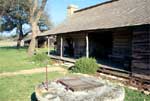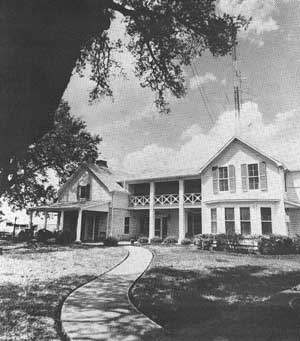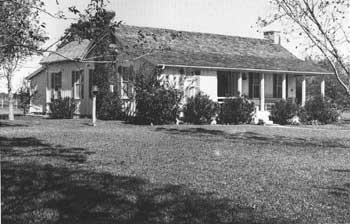






Survey of
Historic Sites and Buildings
 |
Lyndon B. Johnson National Historic Site Texas |
 Lyndon B. Johnson National Historic Site |
| ||
Throughout his life, President Johnson was closely identified with the Texas hill country. This park contains three residences and several other structures that commemorate him. Spanning the years from his birth to his death, they illustrate his ascendancy from modest origins to the office of President.
The first child of Rebekah Baines and Sam Ealy Johnson, Jr., Lyndon was born on August 27, 1908, at a farm on the banks of the Pedernales River near Stonewall in Gillespie County, Tex. Two more children, Rebekah Luruth and Josefa Hermine, also first saw the light of life in this home, a two-bedroom structure that was the smaller of two on their grandparents' farm.
 |
| The ranchhouse as it appeared in 1963, the year Lyndon R. Johnson assumed the Presidency. It looks essentially the same today except that the antenna has been removed and the shrubbery is larger. (Lyndon B. Johnson Presidential Library.) |
In 1913 the Johnsons moved to Johnson City, about 13 miles to the east in Blanco County. They purchased a handsome, one-story frame building facing Ninth Street. There, two more children, Sam Houston and Lucia Huffman, were born. During his years in Johnson City, Sam Ealy pursued careers in real estate, newspaper work, and politics. Meantime, Lyndon had continued with his elementary education.
In 1920 Sam rented out his home and returned to the Gillespie County farm, which he had acquired from the other heirs of his parents. By this time, he was more active in politics than any other field. Because of his long absences while he was serving in the legislature, Lyndon often found himself in charge of the farm. In 1921, however, because of the lack of high schools in the Stonewall vicinity, he moved in with relatives at Johnson City and began his freshman year there. The next year, his family sold the farm and moved back to their Johnson City home.
Upon graduation from high school in 1924, temporarily uninterested in further learning, Lyndon traveled to California, where he held various minor positions before returning home the next year. In 1927, after a couple more years of drifting from job to job, he entered Southwest Texas State Teachers College in San Marcos. After receiving an elementary teacher's certificate, however, he dropped out the next year to become principal and teach grade school at Cotulla, but reentered the following year and received his Bachelor of Science degree in August 1930. A few months later, he accepted a high-school teaching position at Houston.
That same year, Sam Johnson decided to move once again, this time to San Marcos; 4 years later, he again went back to Johnson City. After his death in 1937, his widow rented out the Ninth Street home and moved to Austin. She remained there until she passed away in 1958.
Meantime, in 1934 Lyndon had married Claudia Alta ("Lady Bird") Taylor of Marshall, Tex., and his political career had flourished. He spent much of his time in Washington, D.C., but returned to Texas as often as his official duties allowed. In 1951 he purchased the LBJ Ranch, about a mile west of the site of his birthplace. It had been owned by an aunt and uncle for four decades. Johnson's permanent home until his death early in 1973, it served as the "Texas White House" during his Presidency (1963-69).
 |
| Johnson Birthplace. (National Park Service, Fred Mang, Jr.) |
The birthplace home, which had been constructed by Lyndon's grandfather about 1889, passed through the hands of various owners after Sam Johnson sold it in 1922 and was torn down in the 1930's. In 1964 Johnson family interests repurchased the site, deeded it to the Johnson City Foundation, and commissioned Austin architect J. Roy White to begin a reconstruction. He based it on a thorough archeological investigation, information supplied by family members and others who remembered the house, and contemporary photographs. Some of the materials utilized in the reconstruction came from an existing building nearby and may once have formed a part of the birthplace. The Johnson City Foundation, which opened the structure to the public in 1966, donated it to the Federal Government 4 years later, the year after Congress authorized the establishment of Lyndon B. Johnson National Historic Site.
The reconstruction is a typical Texas farmhouse of the late 19th century. An open central hallway, or "dogtrot," runs between two large rooms on the east and west sides. In the outer wall of each room is a stone fireplace with wooden mantel. A wooden porch, the western end of which is enclosed to provide a "shed room," extends across the entire front of the structure. An ell to the rear of the western room contains a dining room, old kitchen, and a modern kitchen that did not exist in the original house. To the east of the dining room is a back porch, a shed room, and a modern bath. The house is furnished with Johnson family items or period pieces.
The boyhood home in Johnson City, erected by W. C. Russell in 1901, was originally a small framehouse, L-shaped and one story high. It contained a front parlor, east bedroom, hall, dining room, and kitchen. In 1907 Russell added a west wing to provide two additional bedrooms. Two L-shaped porches flanked the front, a screened porch was situated to the rear of the eastern bedroom and hall, and an open porch and a bath were behind the west wing. Except for minor improvements made by the Johnsons in 1934, the basic floor plan remained essentially unaltered until 1964.
In the latter year, the Johnson family remodeled the structure for use as a community center. Major changes included the removal of interior partitions in the eastern section of the house to provide a large room for group meetings, conversion of the west wing into a caretaker's apartment and bath, and modernization of the kitchen. Also, the rear screened porch was glassed in and the house was carefully refurnished with original or other Johnson family items. In 1965 the Johnson City Foundation acquired the structure and opened it to the public. Five years later, the foundation deeded it to the National Park Service. The house, grounds, and outbuildings have been restored to their appearance as of 1925.
 |
| After Johnson decided not to seek another full term in March 1968, he briefed all the Presidential candidates. Here, in August, on the porch outside his office at the ranch, he counsels Republican candidate Richard M. Nixon. (Lyndon B. Johnson Presidential Library, Michael Geissinger, 1968.) |
Late in 1972, not long before his death, Lyndon B. Johnson donated part of the LBJ Ranch, including the house and more than 200 acres of land, to the National Park Service. His widow occupied the two-story, frame ranchhouse. Visitors may tour the property and view the buildings. One interesting structure is an airplane hangar that Johnson often used for press briefings.
| ADDITIONAL INFORMATION |
|
LBJ's Texas White House "Our Heart's Home" |
Other donations by the Johnsons have enabled the National Park Service to acquire a 36-acre tract and log house near Johnson City that the President's grandfather used as a headquarters for his cattle operations and the one-room Junction School in the vicinity of the birthplace that Johnson attended for a short time when he was only 4 years of age. The log house and adjoining rock buildings have been restored and an interpretive facility built.
In addition to the properties under the jurisdiction of the National Park Service, three other pertinent sites are in the area. Johnson's grave is in a family cemetery adjacent to the birthplace. Lyndon B. Johnson State Park, across the Pedernales River from the LBJ Ranch, interprets the region and its influences on his life through exhibits and programs. The Lyndon B. Johnson Library, on the campus of the University of Texas at Austin and operated by the General Services Administration, serves as a center of scholarly research and a historical museum.
 |
 |
http://www.cr.nps.gov/history/online_books/presidents/site59.htm
Last Updated: 04-Feb-2004